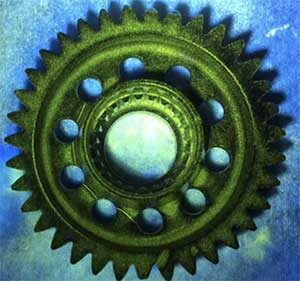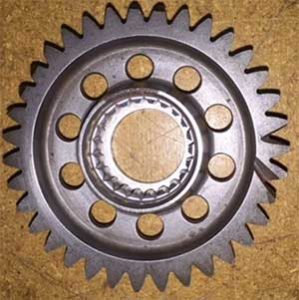Ultrasonic Cleaning for Aircraft Engine Parts
The Tulsa, OK, base of American Airlines overhauls CFM56-7B, GE CF-6, and Pratt & Whitney JT8D-219 jet engines, and performs maintenance on Boeing and McDonald Douglas aircraft in its fleet. The base utilizes ultrasonic cleaning as a key part of its nondestructive testing (NDT) procedure to insure aircraft engine parts meet specification.
What is Nondestructive Testing?

Jonathan M. Adair serves as NDT Level III Specialist at the Tulsa facility, and explains that the procedure involves the testing aircraft engine components using one or more of the following methods:
- Ultrasound
- Eddy Current
- Radiography
- Thermography
- Magnetic Particle and
- Liquid Penetrant.
“The last two methods are where we employ ultrasonic cleaning,” he says.
He explains that magnetic particle testing detects minute discontinuities such as cracks at or near the surface in ferromagnetic metals such as iron, steel, nickel, and cobalt. Liquid penetrant works much the same way when colored dyes penetrate the cracks.
How Ultrasonic Cleaners are Employed in Nondestructive Testing
Mr. Adair says “It is essential that all traces of dyes and particles are removed after the testing procedure. An ultrasonic cleaner has been most effective in assuring this is achieved. It is faster, more effective and less costly than vapor degreasing and other cleaning methods, and does not damage aircraft engine parts.”
The ultrasonic cleaner is used to accomplish two tasks:
- cleaning disassembled parts by NDT inspectors following standard operating procedures relating to jet aircraft maintenance schedules
- Performing quality check standards
“Quality check standards,” he explains, “is subjecting a test panel with defects to the cleaning process to ensure that all traces of dye and other contaminants are removed. This exercise is performed on a daily basis to check the performance of the Liquid Penetrant line.”
Ultrasonic Cleaning 101
Cleaning is accomplished by billions of microscopic vacuum bubbles that implode on contact with items placed in the ultrasonic cleaner’s bath.
Bubbles are created by generator-powered transducers that vibrate at ultrasonic frequencies. Attached to the bottom of an ultrasonic cleaner’s tank transducers cause the bottom to act like a membrane, thus creating the bubbles.
When bubbles contact the surfaces of parts being cleaned they implode with tremendous force to blast loose and carry away contaminants. Due to their small size they can penetrate minute cracks and crevices unreachable by brushes, sprays or other mechanical methods.
An Ultrasonic Cleaning Cycle for Jet Aircraft Engine Components

The Tulsa maintenance facility uses a 37 kHz S180H Elma ultrasonic cleaner (replaced by the Select 180) provided by Tovatech. It has a cleaning tank capacity of 4.7 gallons and dimensions of 12.9 x 11.8 x 7.9 inches deep. The cleaner is equipped with a heater and timer that use LED lights to indicate both set and actual cleaning time and cleaning temperature.
Other useful features on the Elma unit include
- a sweep mode that assures even distribution of ultrasonic cleaning energy throughout the bath
- a degas mode that speeds the removal of air in fresh cleaning solutions
- An on-off switch for the unit
- A switch to initiate or turn off ultrasonic cleaning cycles
- A lid to reduce noise and cleaning solution evaporation. Reversed as a tray it collects drained solutions from baskets.
An Ultrasonic Cleaning Cycle for Jet Aircraft Engine Parts
“We use Magnaflux Daraclean, a low-foaming, all-purpose alkaline cleaning solution, for our cleaning cycles,” Mr. Adair says. “This is an aqueous solution that can be diluted and used in concentrations up to 25% with tap water.
“All fresh water-based ultrasonic cleaning solutions contained trapped air, and to work effectively the air should be removed. This is the advantage of the degas mode on the Elma ultrasonic cleaner. It speeds the degassing operation.
“The solution is prepared by adding water and Daraclean to the tank in the correct proportions then activating the degas mode. This step also serves to thoroughly mix the solution.
“Cleaning works most effectively the maximum heating temperature of the unit, in this case 80⁰C, which we dial on the on the temperature knob. The S180H is equipped with an autostart that will initiate ultrasonic cleaning action when the set temperature is reached.
“In the meantime we carefully arrange parts to be cleaned in the cleaning basket. When the cleaning solution reaches the set temperature we lower the basket into the solution and cover the tank.
“Depending on the number and condition of parts, cleaning cycles range from 30 minutes to an hour although the S180 can run up to 12 hours with an auto shut-off at that point.
“At the end of the cycle the basket is removed and allowed to drip into the tray. Cleaned parts are hot, and flash dry. After inspection parts are stored until ready for use.”
Ultrasonic Cleaning Solution Replacement
Contaminants removed during ultrasonic cleaning operations build up in the solution, necessitating replacement. In this case, parts being cleaned do not contain gross contaminants and therefore are generally replaced on a monthly basis.
At that time the tank is drained and cleaned following procedures on the user manual. Fresh solution is prepared and degassed, ready for the next cleaning cycles.
Contact the scientists at Tovatech for more information on the S180H and other ultrasonic cleaners and cleaning solution formulations to solve your cleaning challenges.
